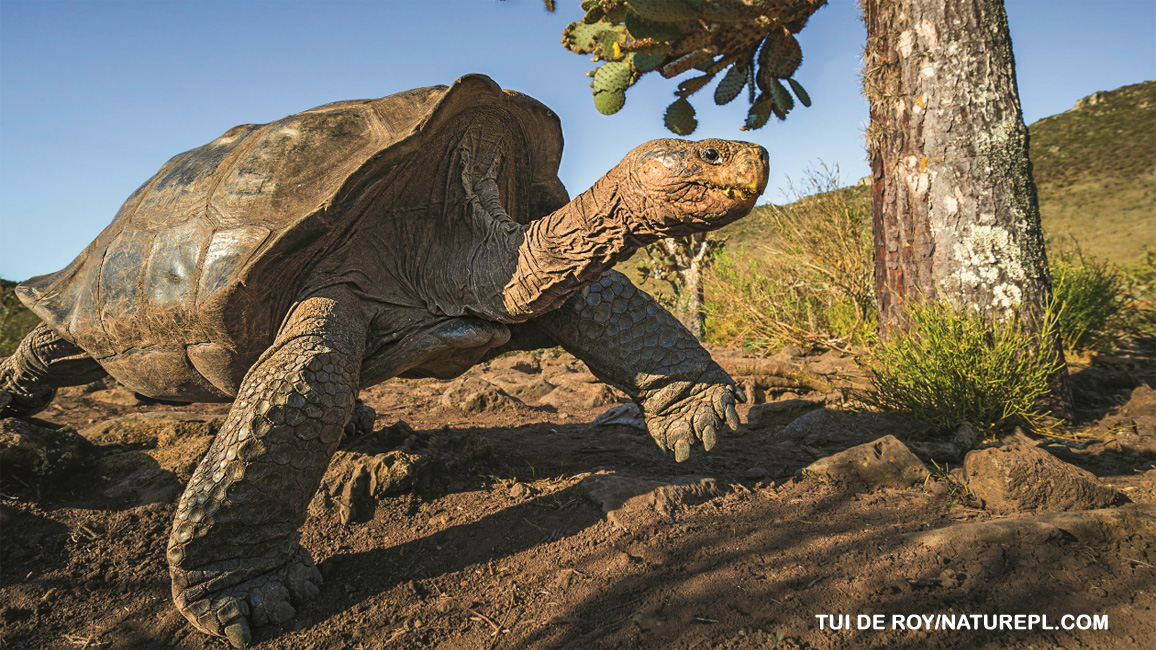
Galápagos Tortoises
By Kate Hofmann; photos by Tui De Roy/Naturepl.comDays are slow and life is long for Galápagos tortoises. These ancient animals keep trekking onward, one step at a time.

The Galápagos (guh-LAHpuh-gohs) Islands (see map) are home to a wild variety of animals, from blue-footed boobies to ocean-going iguanas and even penguins. But it’s the giant tortoises that many people think of first. Galápagos tortoises are the largest tortoises in the world.
They can weigh more than 500 pounds and live to be more than 150 years old. At least 10 different species call different parts of the Galápagos Islands home. They’ve all faced threats, and some are already extinct. The wrinkly tortoise in this photo lives on a small island called Pinzón. Life for the Pinzón tortoises got a lot better in 2012, when people got rid of the island’s rats.
The rats had come with sailors long ago. From then on, no baby tortoises had a chance to grow up—rats ate them all. People helped by collecting tortoise eggs and raising hatchlings until they were big enough to survive the rats. But now, with the rats gone, the Pinzón tortoises are breeding on their own again. That’s not the only good news for Galápagos tortoises. Read on for the latest!

EAT YOUR GREENS
Galápagos tortoises grow to their super size one mouthful of plants at a time. Grass, leaves, flowers, fruits, and cactuses are all on the menu. But if they have to, the tortoises can survive for a year with no food or water! Seems like a good survival strategy, doesn’t it? But it turned out to be just the opposite for the tortoises. After people first came to the Galápagos Islands in 1535, ships began stopping there. The sailors took huge numbers of tortoises aboard to eat them. The tortoises didn’t need to be fed, and they provided fresh meat during long sea journeys.
On top of that, settlers arrived and cleared the land to grow crops. They also brought goats, cows, dogs, pigs, and other animals, which ate the tortoises and their food and trampled their nests. Scientists believe there were once around 250,000 Galápagos tortoises. But by the 1970s, only about 3,000 remained.
DOMES AND SADDLEBACKS
The islands of the Galápagos are quite different from each other. Some have wetter climates and more plants. Others are drier and have fewer plants. The tortoises that live on those islands have differences, too. On dry islands, the tortoises tend to have “saddleback” shells. A raised part above the tortoise’s neck allows the tortoise to lift its head higher and reach the fruits and leaves of taller plants, such as the prickly pear cactus.
On wetter islands, the tortoises’ shells are dome-shaped. These tortoises don’t need to raise their heads so high because they can find plenty of the food they eat—
grass—on the ground.
Now here’s where it gets really interesting. On the largest island, Isabela, there are both domed and saddleback tortoises. Both can be found on the slopes of Wolf Volcano, the highest peak in the Galápagos. Scientists think that, back when sailors were collecting Galápagos tortoises from different islands, some of the reptiles escaped and swam ashore onto Isabela. There, they mated with the native population. The result was a lot of tortoises with parents of two different species.

TORTOISES LOST AND FOUND
Scientists wanted to know more about the different kinds of tortoises at Wolf Volcano. So they went on a big expedition to the steep slopes of the volcano. They took blood samples from as many tortoises as they could track down. Then they used the blood for tests to learn about the tortoises’ ancestors.
They found something very exciting. Many of the saddleback tortoises at Wolf Volcano have ancestors from two species that they feared were gone forever! One is the Floreana tortoise, which was thought to be extinct 150 years ago. The other is the Pinta tortoise. A single male, called Lonesome George, was believed to be the word’s last Pinta tortoise when he died in 2012 around the age of 100.
Scientists have now moved some of these tortoises from Wolf Volcano to a breeding center on Santa Cruz Island. Many years from now, if the program is successful, new generations of these tortoises may go back to Floreana and Pinta islands.
The total number of Galápagos tortoises is now up to about 20,000—still a lot fewer than before people came to the islands, but a lot more than the low point. Keep trekking, tortoises—slow and steady wins the race.
SUCCESS STORY
By the 1960s, goats had eaten so much of the vegetation on Española Island that only 15 tortoises were left: 13 females and just two males. Scientists started a breeding program to try to increase the population. The San Diego Zoo sent another male (right) that had already spent 40 years in captivity. He was named Diego, and he turned out to be a breeding star: He became the father of about 900 new hatchlings! The goats were removed, and the Española breeding program was a success. In 2020, Diego and the other tortoises got to “retire” and return to the wild. When Diego finally went home, he had been away for 80 years!
















